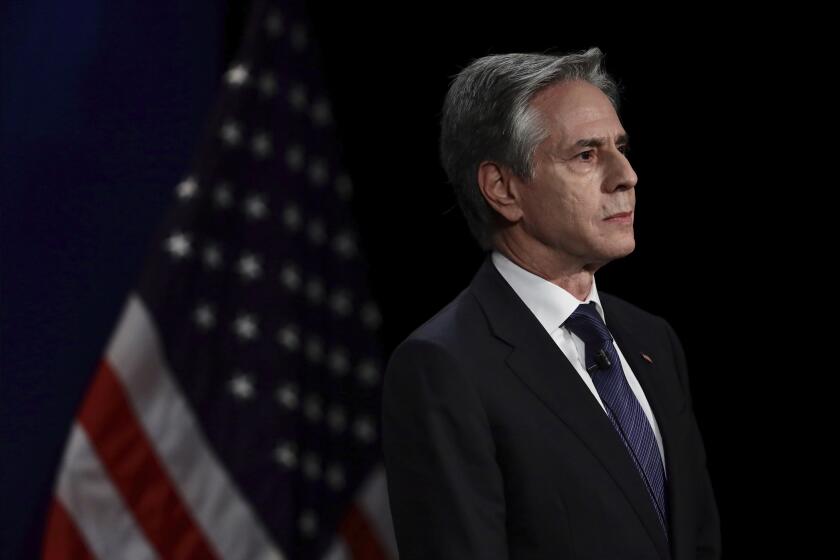Town’s Church Poisoning Leads to Soul-Searching
When it came time to bid farewell to Danny Bondeson, his family and friends filled the pews inside Gustaf Adolph Lutheran Church, spilling out of the chapel’s sanctuary. For a brief hour, they remembered him as the unassuming, dutiful farmhand they had grown up with -- not the murder suspect he had inexplicably become.
Even in May, the ice-choked soil of northern Maine is still too frozen to allow burial. So the Bondesons opted for cremation. Then they joined 150 people inside the same church where 16 congregants were stricken three weeks ago in a mysterious mass poisoning case that left one man dead and was capped by Bondeson’s baffling suicide.
In this expanse of potato fields and pines near the Canadian border, a community where murders are as rare as traffic jams and old-line Swedish families can recite one another’s lineage going back generations, the notion that a native son might have plotted lethal harm defies comprehension.
Maine State Police detectives and FBI behavioral profilers have struggled to solve the case, hinting that old grudges within the tiny congregation of the town’s sole Lutheran church led Bondeson and perhaps others to target fellow worshippers for murder.
The townspeople of tiny New Sweden say that even if Danny Bondeson killed, he will always be family.
“You live with a man 53 years, you get to know him inside and out,” said Sara Anderson, who runs one of New Sweden’s two roadside stores. “It just isn’t like Danny. Could he have done this by himself? Was he put up to it? All we know is something happened at our church and we need answers.”
Anderson was among the mourners who streamed into Gustaf Adolph last week to celebrate the Danny Bondeson they preferred to recall -- a quiet man who “couldn’t hurt a soul.” Sitting in the crowd were several recuperating poisoning victims.
“We all feel for his family,” Anderson said. “And we’re all going to miss him.”
The search for New Sweden’s killer has proceeded like an Agatha Christie mystery directed by Ingmar Bergman, set against the bleak landscape of Aroostook County, a vast tract of forests and farmland that stretches hundreds of miles toward Quebec. New Sweden is one of four postage-stamp towns in a section known as the Swedish Colony, settled by immigrant families in the 1870s. Barely 600 people live in New Sweden now, still prizing their isolation from urban America and their dependence on one another.
Those ties were sundered, police say, when someone intentionally dumped a concentrated dose of arsenic into a coffee urn stored in the church’s kitchen. Many of the 16 parishioners overcome after services April 27 are still recovering; several remain hospitalized. Retired railroad electrician Walter Reid Morrill, 78, died of cardiac arrest, weakened by the poison. Among several of the sickened survivors were Bondeson’s closest friends.
Five days later, troopers summoned to an old house on a backwoods lane found the 53-year-old Bondeson dead of a self-inflicted gunshot wound. Nearby, they found a note “strongly” linking him to the crimes, said State Police Lt. Dennis Appleton, who heads the murder investigation.
Since Bondeson’s suicide May 1, detectives turned up hints of schisms within New Sweden’s churchgoers. Left leaderless after its pastor departed two years ago, Gustaf Adolph’s shrinking congregation was divided over its future and perhaps, police said, by personal grudges. Most of his investigators, Appleton said, are convinced Bondeson did not act alone. But they still have scant evidence supporting the possibility of accomplices.
“We’re not ready to close this just because Daniel Bondeson took his own life,” Appleton said. “We’re trying to rule in or out whether more than one person was involved. We’d like to be comfortable with our final decision.”
There has been precious little comfort in New Sweden since the Sunday morning last month when the faithful gathered in Gustaf Adolph’s weather-beaten yellow chapel. After services, they drifted over to the church hall. There was coffee for the adults, punch for the children and sweets left over from a bake sale the day before.
“People around here take their coffee straight,” said the Rev. James Morgan, pastor at Trinity Evangelical Lutheran Church in nearby Stockholm. Their conversations often turned to the weather and the land, to gossip and plans for a summer solstice celebration.
“Nothing earth-shaking, just the usual things you’d hear at a country church,” said Morgan, who often filled in at Gustaf Adolph. He was away that Sunday, leaving a congregation member to minister to the flock.
One by one, congregants filled their cups. Ralph Ostlund, who often went with Bondeson on ski outings, had three. Walt Morrill had only half a cup. He had been recuperating from a quintuple bypass earlier in the year, eager to return to the golf course in nearby Caribou. As the parishioners talked on, some began to swoon. Complaining his coffee tasted “funny,” Morrill staggered out of the parish hall, assisted by his wife to their house next door.
Overcome by cramps and vomiting, he was taken by ambulance to Cary Medical Center, where he died early the next day.
“All we know is it was a very hairy dose,” said his son, Ronald Morrill.
By then, the emergency room had filled with stricken parishioners. Some were airlifted to a trauma center in Bangor, two hours to the south. Health authorities descended on the church, focusing first on food poisoning. But the next day, toxicology tests on the overcome patients and an analysis of the refreshments left in the hall zeroed in on a single source: arsenic.
“That’s dangerous stuff,” said Alwin Espline, 75, who served for 19 years as one of New Sweden’s governing selectmen. “The old farmers around here used to use it all the time. But I haven’t seen any in years.”
Farmers once spread the poison on potato fields to kill the leafy tops of the crop. But in recent years, they turned to “roto beating,” using tractors to slice off the unwanted vegetation.
Health authorities tried to pinpoint the source. They checked local wells but found nothing unusual. Only the tainted pot had arsenic inside. The church’s supply of coffee had no traces, Appleton said.
The 27-year state police veteran was assigned to head a team of 12 investigators. Appleton was not one to hide his own small-town roots -- or his own anxieties.
His detectives “go to church and school with these folks,” he said. Each day that passed without an arrest stung. “Does it eat at us? Sure. Who wants to go to bed every night with a case like this hanging over us? We’re always open for confessions.”
When one apparently came, five days after the poisoning, the mystery only deepened.
A frantic telephone call summoned troopers to a burnished clapboard house on Bondeson Road. Inside, investigators found Danny Bondeson dead of a single gunshot wound to the chest. An old hunting rifle lay nearby. The position of the gun and the angle of the wound suggested suicide.
Bondeson left a note. Appleton has refused to divulge its contents, but said it left police convinced that “Mr. Bondeson is linked to the killings.” And as they began questioning relatives and friends, detectives wondered if he had an accomplice.
Bondeson was not known for initiative. Nothing permanent came from his six-year stint as a high school physical education teacher and his pursuit of a nursing degree. He was more farmhand than farmer, helping relatives plant and pack organic potatoes. He worked some weekends at a convalescent home in Caribou and took seasonal jobs picking blueberries and shoveling snow from neighbors’ roofs. Walt Morrill was a client, his son said.
“Danny was kind of a free spirit, but he did what we all do around here to get by,” said an old friend, Jerry Nelson.
A lifelong bachelor, Bondeson’s passion was cross-country skiing. Thin and wiry, he had excelled since high school, competing in grueling 50-mile races. And he was a member in good standing at Gustaf Adolph. He had served on the church board as the congregation dwindled and faced an uncertain future.
Anxious to land a new pastor, church members were considering merging with another Lutheran church, a controversial step that met with opposition.
And they debated whether to change their Communion ritual.
For decades, they had followed the age-old Lutheran practice of observing the Christian Eucharist at the altar. A congregant known as an officiant would approach the front of the sanctuary and bless the bread and wine while facing away from the churchgoers.
But in adopting a reform now practiced in many Lutheran congregations, Gustav Adolph’s members voted late last year to allow officiants to face the churchgoers and perform the ritual at a Communion table, instead of at the altar.
“We’d been talking about it for months,” Morgan said. “The intent was to make the church more marketable for a new pastor.” When the final decision was made, it was unanimous, the pastor said: “There was no bitterness that I saw. People didn’t raise their voices.”
But there were hard feelings over the church’s use of a Communion table donated by the Bondesons, Appleton said.
The family, described by Morgan as “pillars of the church,” had come forward when the congregation cast about for a donor early this year. Donating an altar or a stained-glass window is a time-honored way of keeping “our history alive,” said Espline, the former selectman.
Danny Bondeson had left the board, but other relatives stayed active. His sister, Norma, a retired Air National Guard lieutenant colonel who sometimes lived with him, took his place. Danny and his relatives agreed to chip in to pay for the table.
“My aunt asked if I wanted to join in with the rest of the family,” said Sven Bondeson, Danny’s nephew. “Of course I said yes.”
But after the polished oak table was dropped off at the chapel in February, it sat in storage, unused. When the Bondesons pressed to find out why, they were told it was not yet time.
Sven Bondeson insists the family understood.
“It’s like everything else at the church,” he said. “They had to have a council meeting to formally accept it.”
But hard feelings over the table, Appleton said, was one possible motive for Danny Bondeson’s role in the poisonings.
“It’s one of the straws that broke the camel’s back,” he said.
Like police, Danny Bondeson’s neighbors are sifting backward in search of hints of bitterness and rage. Looking for a possible accomplice, investigators have also asked the congregation’s 50 members to submit to DNA tests and fill out questionnaires. By late last week, 40 had complied.
But those who knew Danny well said there were few glimmers of a hidden side. Rita Stadig, 76, a second cousin of his, said he showed sudden irritation during a visit two years ago when she complained to him that her brother was trying to wrest away the house she inherited.
“I never seen him like that before,” she said. “He took my brother’s side, and he said angry words to me.”
The day after the poisonings, Danny showed up at Sven Bondeson’s red barn to help him pack potatoes. The two men briefly discussed the mystery, then let it drop.
“We didn’t even know it was arsenic at that point, but he didn’t seem to make much of it,” the nephew recalled. “It was basically, ‘I wonder what happened up there.’ And he said, ‘Yeah.’ ”
Like everyone else in New Sweden, Sven Bondeson wonders if the relative he had known all his life became a criminal who died alone in the old house down the road.
“The family can’t really grieve yet because we still don’t know what happened,” he said, stubbing out a cigarette in the hard earth.
“All we do is ride around town and play it over and over in our heads. Everyone in town’s doing the same thing.
“We all keep saying it doesn’t make sense,” he said. “That’s the understatement of the year.”
More to Read
Sign up for Essential California
The most important California stories and recommendations in your inbox every morning.
You may occasionally receive promotional content from the Los Angeles Times.






